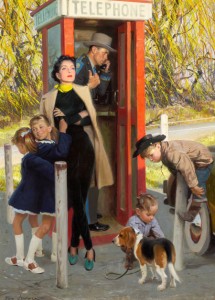 I’m beginning this post with a request, please help me find where this illustration was published and for what story it was created. I’ve already benefited from assistance from a variety of collectors and enthusiasts in this search, but we’ve had no success. If someone can find the citation for this image, I will re-address it in a second post. Without a text to go with this anachronistic Tom Lovell illustration The Blue Hour, we are left with only our eyes and our knowledge of American life in the 1950s to aid our understanding of what we see. So what is there?
I’m beginning this post with a request, please help me find where this illustration was published and for what story it was created. I’ve already benefited from assistance from a variety of collectors and enthusiasts in this search, but we’ve had no success. If someone can find the citation for this image, I will re-address it in a second post. Without a text to go with this anachronistic Tom Lovell illustration The Blue Hour, we are left with only our eyes and our knowledge of American life in the 1950s to aid our understanding of what we see. So what is there?
In the background a trooper stands in a phone booth talking on the phone and gesturing with his thumb back at the woman standing outside the booth. In the foreground appear to be two sets of children. On the right are two young boys and a hound on a leash. One in a cowboy hat and boots has climbed the barrier pole to the right of the phone booth. His feet are balanced at either side of the pole and his upper body leans over the pole. Behind him a rear tie and bumper of a car can be seen. The boy next to him is crouched on the ground and his body is partially obscured by the dog in front of him. This boy’s hair appears to be in a rather disorderly mess. To the left two girls stand back to back, one slightly older than the other, but they wear identical clothing: white knee socks and saddle shoes, dark blue long sleeved dresses with white ruffles at the collar and at their hems.
In the midst of all of this commotion stands a regal dark haired women whose slacks and top are black. She wears a bright yellow scarf around her neck and has a camel coat thrown over her shoulders. She leans against the edge of the phone booth with her arms folded and her legs crossed. Her shoes—oh her shoes—are turquoise heels whose sides and backs are edged with a turned black leather collar. The toes sport little black ties.
While the trooper appears to be gesturing at the woman, the children seem to have nothing to do with her and she appears to have nothing to do with anyone else in the scene. Indeed instead of reading the image as a whole with each part relating to the others, this painting comes across as if it were a composite of four different vignettes. These four distinct scenes may be paired two and two. That is to say that the Trooper may be compared to the classy disdainful woman and the two sets of children may be contrasted as girls versus boys–neat and refined girls as opposed to scruffy and active boys.
Using the image to guess at the story, my conjecture is that the four children have nothing to do with the woman, but are in fact the trooper’s responsibility. Not only is the lady’s outfit simple but distinctive, along with those very unique shoes, but also her gaze away from and noninvolvement in the scene make her appear to be more like a member of the beat generation than the mother of part or all of the wholesome brood arrayed jostling around her. She is passive and withdrawn, they are active and engaged. The trooper is focused on relaying the situation (whatever it is) and the women gazes outwardly while everything else in the composition is focused inwardly.
Since Lovell was so good at visually telling a coherent story in his illustrations, the disjointedness of this composition must be intentional. So how about this for an interpretation: The trooper has been doing kid duty: he has dragged the scruffy boys and their dog along as he picked the girls up from some sort of class, dance perhaps. As he transports his brood home, he come across a damsel in distress, the beatnik babe. So he picks her up and takes her with them to find a phone booth and call for assistance. I love that it is the trooper in the phone booth, and because the booth’s door is open he cannot transform into Superman, or anyone else. He remains the clean-cut do-gooding slightly annoyed public servant. She remains detached from the tumult around her. This explanation posits a reversal of gender roles for the adult characters in contrast with the gender reaffirming aspects of the children’s depictions, reflecting the beginnings of strain and readjustment in American post-war society. Whew!
February 11, 2010
By Joyce K. Schiller, Curator, Rockwell Center for American Visual Studies
Norman Rockwell Museum






